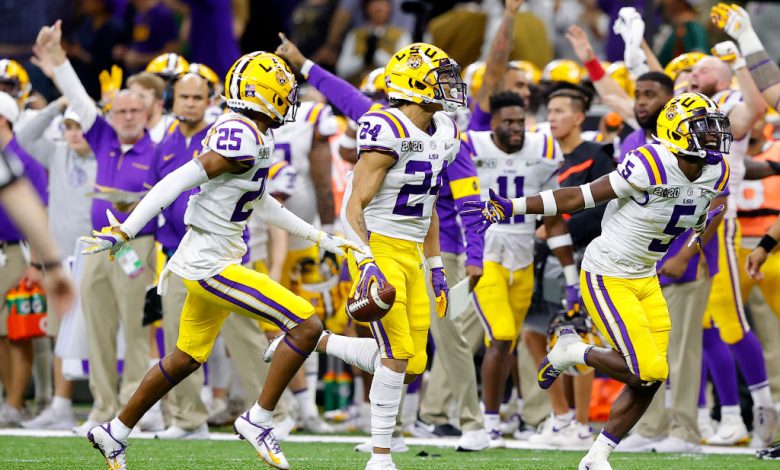A dwindling collegiate tradition, Texas is the most recent school to abolish its spring game.

In the world of college football, the spring game has long been a cherished tradition. For decades, schools across the country have hosted these annual exhibitions to give fans a glimpse of the upcoming season, offer players a chance to showcase their skills in a live setting, and solidify team dynamics in a more structured, game-like atmosphere. It was a day that brought excitement, camaraderie, and a sense of anticipation as fans packed stadiums to watch their teams in action before the fall season even began.
However, over recent years, the spring game—once a staple of college football—has become increasingly scarce. More and more schools are opting to cancel or alter the format of their spring games, citing a variety of reasons, from player safety to the logistical difficulties of organizing such events. The University of Texas is the latest high-profile school to announce that it will no longer hold a traditional spring game, signaling the potential end of an era for this beloved college football tradition.
In this article, we will explore the reasons behind the decline of the spring game, why Texas made the decision to abolish it, and what this change means for the future of collegiate football. We will also consider the implications for fans, players, and coaches as this time-honored event fades into the background.
The Rise of the Spring Game
The spring game has its origins in the early 20th century. It was initially conceived as a way for teams to get valuable practice time in a game-like setting before the fall season, but over the years, it became much more than just a scrimmage. These games evolved into a spectacle, with many schools viewing them as an opportunity to engage with their fanbase and showcase their programs. For schools with passionate fan bases, such as Texas, Alabama, and Michigan, the spring game became an important part of the offseason calendar.
In the past, the spring game served several critical purposes. For coaches, it was a chance to assess their players in game conditions after months of training. With most teams only allowed a limited number of spring practices, the spring game provided a final opportunity to evaluate new recruits, underclassmen, and positional battles. For fans, the spring game was a rare opportunity to watch their team in action without the pressure and stakes of the regular season.
Furthermore, these games were often used as an unofficial start to the college football season. Coaches and players would use the event as a launching point for the grueling summer workouts that would follow, helping to build team cohesion and camaraderie. For fans, it was a way to check in on the progress of their team, especially after key departures or new additions. In many cases, the spring game was also a key moment for schools to promote new players and drum up excitement for the fall campaign.
Texas, like many other powerhouse programs, embraced the spring game tradition for years. The Longhorns’ spring game was often a major event, drawing tens of thousands of fans to Darrell K Royal–Texas Memorial Stadium. With the rise of social media, these games also became opportunities for schools to engage their fan bases on a broader scale, extending the reach of the event far beyond the stadium. The event’s significance, both on and off the field, cannot be overstated.
The Decline of the Spring Game Tradition
While spring games were once a fixture of the college football offseason, in recent years, the tradition has begun to fade. Many schools across the country, including several high-profile programs, have decided to either scale back or eliminate their spring games altogether. The reasons for this decline are varied, but they can largely be attributed to concerns over player safety, financial considerations, and the changing nature of college football.
1. Concerns Over Player Safety
One of the primary factors contributing to the decline of the spring game is the increasing concern over player safety. In recent years, there has been a heightened awareness of the risks associated with football, particularly when it comes to concussions and long-term brain injuries. The NCAA, along with many universities and athletic programs, has made significant strides in addressing player safety through rule changes, improved equipment, and better concussion protocols.
However, the physical nature of the spring game, which often involves players going full-speed in live contact situations, has led many coaches and administrators to reevaluate the necessity of the event. Players already endure rigorous offseason workouts and spring practices, and adding a full-contact game to the mix can increase the risk of injuries, which can have a significant impact on a team’s performance heading into the fall.
Texas, like many other schools, has seen the value in prioritizing player health over the spectacle of a spring game. Given the increasingly high stakes of each season, teams cannot afford to lose key players to injury during an event that ultimately has no bearing on their record. For Texas, the decision to abolish the spring game may reflect a broader shift in how college football programs are approaching player safety, with an emphasis on protecting players’ long-term health over short-term fan engagement.
2. Financial and Logistical Considerations
Another key factor driving the decline of spring games is the financial and logistical burden that comes with organizing such events. Spring games are not free to put on—they require significant planning, staffing, and resources. From security and concessions to stadium operations and media coverage, the costs of hosting a spring game can add up quickly.
For many schools, the financial return from a spring game does not justify the costs associated with it. While it can serve as a promotional tool for the program, schools are increasingly finding that other methods of engaging fans—such as virtual events, social media promotions, and year-round content—are more cost-effective ways to maintain fan interest. Additionally, the sheer logistics of hosting a large-scale event in the offseason, when most staff members are focused on recruiting, player development, and facility maintenance, can be overwhelming.
At Texas, where resources are abundant, but the competition for attention and attendance is fierce, the return on investment for a spring game simply may not be as high as it once was. The program likely felt that investing in player development and focusing on more efficient means of engaging with fans was a better use of their time and money.
3. The Changing Landscape of College Football
College football has undergone a significant transformation in recent years. The sport is no longer just about the game itself—it is now a multi-billion-dollar industry with an ever-expanding media presence. The increased commercialization of the sport has shifted the way teams approach fan engagement and public relations. With the rise of the College Football Playoff, the massive growth of conference realignment, and the expansion of media rights deals, the landscape of college football has become more complex than ever before.
In this new environment, spring games may no longer hold the same significance they once did. Teams can engage with their fanbases in other ways, such as through media days, recruiting events, and year-round digital content. With television contracts and streaming services bringing the sport directly to fans, it has become easier for programs to maintain a presence without the need for an in-person event. The spring game, once an integral part of the football calendar, now competes with a multitude of other content and events that capture the attention of fans and media.
For Texas, the allure of the spring game has diminished in the face of this changing dynamic. The Longhorns are in the midst of a transformative period under head coach Steve Sarkisian, with big expectations for the future. The program may have felt that dedicating time and resources to a spring game—an event that doesn’t directly contribute to team success—was less important than focusing on the aspects of the program that will have a more tangible impact on the upcoming season.
What the Abolition of the Spring Game Means for Texas
The decision by Texas to abolish its spring game is not merely a reflection of changing priorities for the program—it also signals the broader evolution of college football and the shifting relationship between teams and their fanbases.
1. Fans Will Miss Out on a Tradition
One of the immediate impacts of this decision will be on Texas fans, who have long used the spring game as a way to stay connected to their team during the offseason. For many, the spring game served as a precursor to the fall season, giving them a chance to see new recruits, evaluate returning players, and get a sense of the team’s direction. The cancelation of this tradition means that fans will lose out on one of the few opportunities to get a firsthand look at the team before the season begins.
In addition to the on-field action, the spring game also provided a sense of community. It was an event where fans of all ages could come together to celebrate their team, meet other supporters, and enjoy a day at the stadium. The social aspect of the event, while perhaps secondary to the football itself, was still a key component of the experience for many Texas supporters.
2. Coaches and Players Will Focus on Development
From a practical perspective, the abolition of the spring game allows Texas to focus more on player development and preparation. With the demands of a modern college football program—including recruiting, strength and conditioning, and position-specific coaching—it is becoming increasingly difficult to dedicate time to a game that provides limited return on investment. By eliminating the spring game, Texas can allocate those resources toward ensuring that players are fully prepared for the rigors of the upcoming season.
For the coaching staff, particularly head coach Steve Sarkisian, the focus will shift to refining the team’s strategy, working on individual player improvement, and ensuring that the team is in peak form come fall. While the spring game offered a public forum to evaluate talent, it is not a necessity for the team’s overall development.









